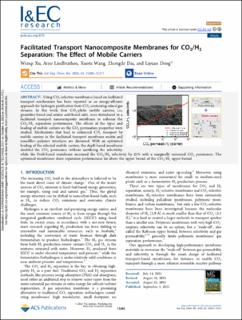| dc.contributor.author | Xu, Wenqi | |
| dc.contributor.author | Lindbråthen, Arne | |
| dc.contributor.author | Wang, Xueru | |
| dc.contributor.author | Dai, Zhongde | |
| dc.contributor.author | Deng, Liyuan | |
| dc.date.accessioned | 2023-12-19T09:48:08Z | |
| dc.date.available | 2023-12-19T09:48:08Z | |
| dc.date.created | 2023-10-03T09:05:20Z | |
| dc.date.issued | 2023 | |
| dc.identifier.issn | 0888-5885 | |
| dc.identifier.uri | https://hdl.handle.net/11250/3108151 | |
| dc.description.abstract | Using CO2-selective membranes based on facilitated transport mechanisms has been reported as an energy-efficient approach for hydrogen purification from CO2-containing mixed gas streams. In this work, four CO2-philic mobile carriers, i.e., guanidine-based and amino acid-based salts, were introduced to a facilitated transport nanocomposite membrane to enhance the CO2/H2 separation performance. The effects of the types and loading of mobile carriers on the CO2 permeation properties were studied. Mechanisms that lead to enhanced CO2 transport by mobile carriers in the facilitated transport membrane matrix and nanofiller–polymer interfaces are discussed. With an optimized loading of the selected mobile carriers, the AspK-based membrane doubled the CO2 permeance without sacrificing the selectivity, while the ProK-based membrane increased the CO2/H2 selectivity by 25% with a marginally increased CO2 permeance. The optimized membranes show separation performances far above the upper bound of the CO2/H2 upper bound. | en_US |
| dc.language.iso | eng | en_US |
| dc.publisher | ACS Publications | en_US |
| dc.rights | Navngivelse 4.0 Internasjonal | * |
| dc.rights.uri | http://creativecommons.org/licenses/by/4.0/deed.no | * |
| dc.title | Facilitated Transport Nanocomposite Membranes for CO<inf>2</inf>/H<inf>2</inf> Separation: The Effect of Mobile Carriers | en_US |
| dc.title.alternative | Facilitated Transport Nanocomposite Membranes for CO<inf>2</inf>/H<inf>2</inf> Separation: The Effect of Mobile Carriers | en_US |
| dc.type | Peer reviewed | en_US |
| dc.type | Journal article | en_US |
| dc.description.version | publishedVersion | en_US |
| dc.source.pagenumber | 15202–15211 | en_US |
| dc.source.volume | 62 | en_US |
| dc.source.journal | Industrial & Engineering Chemistry Research | en_US |
| dc.source.issue | 37 | en_US |
| dc.identifier.doi | 10.1021/acs.iecr.3c02400 | |
| dc.identifier.cristin | 2181174 | |
| dc.relation.project | Norges forskningsråd: 294533 | en_US |
| cristin.ispublished | true | |
| cristin.fulltext | original | |
| cristin.qualitycode | 2 | |

